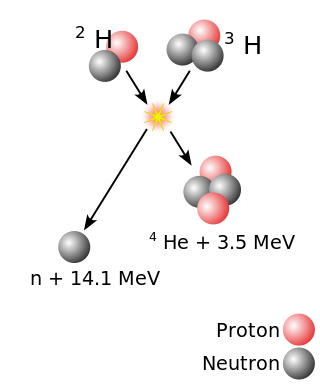Deuterium–tritium fusion
Type of fusion From Wikipedia, the free encyclopedia
Deuterium–tritium fusion (DTF) is a type of nuclear fusion in which one deuterium (2H) nucleus (deuteron) fuses with one tritium (3H) nucleus (triton), giving one helium-4 nucleus, one free neutron, and 17.6 MeV of total energy coming from both the neutron and helium. It is the best known fusion reaction for fusion power and thermonuclear weapons.

Tritium, one of the reactants for DTF, is radioactive. In fusion reactors, a 'breeding blanket' made of lithium orthosilicate or other lithium-bearing ceramics, is placed on the walls of the reactor, as lithium, when exposed to energetic neutrons, will produce tritium.[1]
Concept
In DTF, one deuteron fuses with one tritium, yielding one helium nucleus, a free neutron, and 17.6 MeV, which is derived from about 0.02 AMU.[2] The amount of energy obtained is described by the mass–energy equivalence: E = mc2. 80% of the energy (14.1 MeV) becomes kinetic energy of the neutron traveling at 1/6 the speed of light.
The mass difference between 2H+3H and neutron+4He is described by the semi-empirical mass formula that describes the relation between mass defects and binding energy in a nucleus.
Discovery
Evidence of DTF was first detected at the University of Michigan in 1938 by Arthur J. Ruhlig.[3][4] His experiment detected the signature of neutrons with energy greater than 15 MeV in secondary reactions of 3H created in 2H(d,p)3H reactions of a 0.5 MeV incident deuteron beam on a heavy phosphoric acid target, 2H3PO4. This discovery was largely unrecognized until recently.[5]
Reactant sourcing
About 1 in every 6700 hydrogen atoms in seawater is deuterium, making it easy to acquire.[2][6]
Tritium, however, is a radioisotope with a short half-life and no natural sources. This can be circumvented by exposing lithium to energetic neutrons, which produces tritons.[2][6] Also, DTF itself emits a free neutron, which can be used to bombard lithium.[7] A 'breeding blanket', made of lithium orthosilicate, is often placed along the walls of fusion reactors so that free neutrons created by DTF react with it to produce more 3H.[8][9] This process is called tritium breeding.
Fusion reactors
DTF is planned to be used in ITER,[8] and many other proposed fusion reactors. It has many advantages over other types of fusion, as it has a relatively low minimum temperature, 108 kelvin.[10]
Spin polarization
Spin-polarized D-T fuel can increase tritium burn efficiency (TBE) by an order of magnitude or more without compromising output. TBE increases nonlinearly with decreasing tritium fraction, while power density increases roughly linearly with D-T cross section. In a 481 MW ARC-like tokamak with unpolarized 53:47 D-T fuel, the minimum tritium inventory was 0.69 kg. Spin-polarizing the fuel with a 63:37 D-T mix reduces the required tritium to 0.03 kg. With advancements in helium divertor pumping efficiency, TBE values of approximately 10%–40% could be achieved using low-tritium-fraction spin-polarized fuel with minimal power loss. This lowers tritium startup inventory requirements.[11]
See also
References
Wikiwand - on
Seamless Wikipedia browsing. On steroids.
